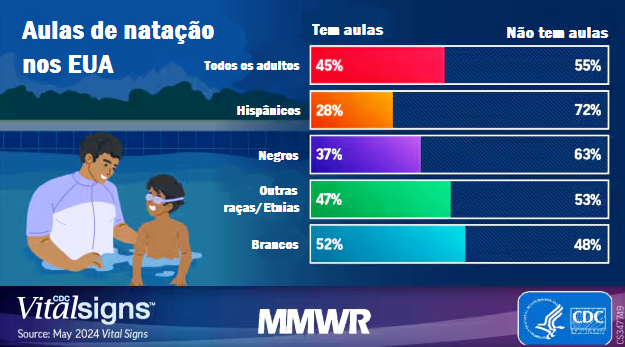Sinais vitais
taxas de mortalidade por afogamento, habilidade de natação auto-relatada, participação em aulas de natação e exposição recreativa à água - Estados Unidos, 2019–2023

Downloads
Palavras-chave:
afogamento, aula de natação, segurança na água, taxa de mortalidade, Estados Unidos, taxas de mortalidade por afogamentoResumo
O afogamento é a causa de aproximadamente 4.000 mortes nos EUA a cada ano e afeta desproporcionalmente alguns grupos etários, raciais e étnicos. As perturbações nas infraestruturas durante a pandemia de COVID-19, incluindo o acesso limitado a ambientes de natação supervisionados, podem ter afetado as taxas e o risco de afogamento. Os dados sobre os fatores que contribuem para o risco de afogamento são limitados. Para avaliar o impacto potencial da pandemia nas taxas de mortalidade por afogamento, foram comparadas as taxas pré e pós-pandemia de COVID-19.
Referências
(1) Centers for Disease Control and Prevention. WISQARS (Web-based Injury Statistics Query and Reporting System)|Injury Center|CDC [Internet]. CDC.gov. 2024. Available from: https://www.cdc.gov/injury/wisqars/index.html
(2) Centers for Disease Control and Prevention. Underlying Cause of Death, 1999-2017 Request [Internet]. Cdc.gov. 2020. Available from: https://wonder.cdc.gov/ucd-icd10.html
(3) Clemens T, Moreland B, Lee R. Persistent Racial/Ethnic Disparities in Fatal Unintentional Drowning Rates Among Persons Aged ≤29 Years — United States, 1999–2019. MMWR Morbidity and Mortality Weekly Report. 2021 Jun 18;70(24):869–74.
(4) Moreland B, Ortmann N, Clemens T. Increased unintentional drowning deaths in 2020 by age, race/ethnicity, sex, and location, United States. Journal of Safety Research. 2022 Jul;82.
(5) Brenner RA, Saluja G, Smith GS. Swimming lessons, swimming ability, and the risk of drowning. Injury Control and Safety Promotion. 2003 Dec;10(4):211–5.
(6) Cost-Effectiveness of an Injury and Drowning Prevention Program in Bangladesh. Pediatrics. 2012 Nov 12;130(6):X43–3.
(7) Hastings DW, Zahran S, Cable S. Drowning in Inequalities. Journal of Black Studies. 2006 Jul;36(6):894–917.
(8) Young E. In Philadelphia, City Pools Bring Relief as Closed Ones Stir Frustration. The New York Times [Internet]. 2023 Jul 23 [cited 2024 Jun 26]; Available from: https://www.nytimes.com/2023/07/23/us/philadelphia-pools-closed.html
(9) Denny SA, Quan L, Gilchrist J, et al. ; Council on Injury, Violence, and Poison Prevention. Prevention of drowning. Pediatrics 2019;143:e20190850. https://doi.org/10.1542/peds.2019-0850 PMID:30877146
(10) Alpert HR, Slater ME, Yoon YH, Chen CM, Winstanley N, Esser MB. Alcohol consumption and 15 causes of fatal injuries: a systematic review and meta-analysis. Am J Prev Med 2022;63:286–300. https://doi.org/10.1016/j.amepre.2022.03.025 PMID:35581102
(11) Carey RN, Crawford G, Jancey J, et al. Young people’s alcohol use in and around water: a scoping review of the literature. Drug Alcohol Rev 2024;43:874-96. https://doi.org/10.1111/dar.13831 PMID:38461491
(12) Wiltse J. The Black–White swimming disparity in America: a deadly legacy of swimming pool discrimination (abstract). J Sport Soc Issues 2014;38:366–89. https://doi.org/10.1177/0193723513520553
(13) American Red Cross. Barriers to accessing swim lessons and water safety information. Washington, DC: American Red Cross; 2021. https://www.redcross.org/content/dam/redcross/Health-Safety-Services/scientific-advisory-council/Red-Cross-Drowning-Prevention-Phase-1-Study-Findings-Final-7-2-2021.pdf
(14) US National Water Safety Action Plan. US national water safety action plan—2023–2032. Washington, DC: US National Water Safety Action Plan; 2023. https://www.watersafetyusa.org/uploads/7/0/6/0/70608285/usnwsap_v7.pdf
(15) National Center for Health Statistics; US Census Bureau. The validity of race and Hispanic-origin reporting on death certificates in the United States: an update. Hyattsville, Maryland: US Department of Health and Human Services, CDC, National Center for Health Statistics; 2016. https://www.cdc.gov/nchs/data/series/sr_02/sr02_172.pdf
(16) US Census Bureau. Methodology for the United States population estimates: vintage 2021. Suitland, Maryland: US Department of Commerce, US Census Bureau; 2021. https://www2.census.gov/programs-surveys/popest/technical-documentation/methodology/2020-2021/methods-statement-v2021.pdf
(17) US Census Bureau. Methodology for the United States population estimates: vintage 2022. Suitland, Maryland: US Department of Commerce, US Census Bureau; 2022. https://www2.census.gov/programs-surveys/popest/technical-documentation/methodology/2020-2022/methods-statement-v2022.pdf
(18) National Center for Health Statistics. Quality profile, rapid surveys system round 2. Hyattsville, Maryland: US Department of Health and Human Services, CDC, National Center for Health Statistics; 2024. https://www.cdc.gov/nchs/data/rss/round2/quality-profile.pdf
(19) National Center for Health Statistics. Quality Profile, rapid surveys system round 1. Hyattsville, Maryland: US Department of Health and Human Services, CDC, National Center for Health Statistics; 2024. https://www.cdc.gov/nchs/data/rss/quality-profile.pdf
____________________________________
OBS.:
(a)Artigo adaptado e traduzido para o português pelos editores de NADAR! SWIMMING MAGAZINE para republicação, conforme normas de submissão do periódico. Versão original em: https://www.cdc.gov/mmwr/volumes/73/wr/mm7320e1.htm LICENÇA ORIGINAL: U.S. Department of Health & Human Services/USA.gov.
MMWR and Morbidity and Mortality Weekly Report are service marks of the U.S. Department of Health and Human Services. Use of trade names and commercial sources is for identification only and does not imply endorsement by the U.S. Department of Health and Human Services. References to non-CDC sites on the Internet are provided as a service to MMWR readers and do not constitute or imply endorsement of these organizations or their programs by CDC or the U.S. Department of Health and Human Services. CDC is not responsible for the content of pages found at these sites. URL addresses listed in MMWR were current as of the date of publication.
Publicado
Como Citar
Edição
Seção
ARK
Licença
Copyright (c) 2024 Tessa Clemens, Briana Moreland, Karin A Mack, Karen Thomas, Gwen Bergen, Robin Lee

Este trabalho está licenciado sob uma licença Creative Commons Attribution-NonCommercial-NoDerivatives 4.0 International License.






